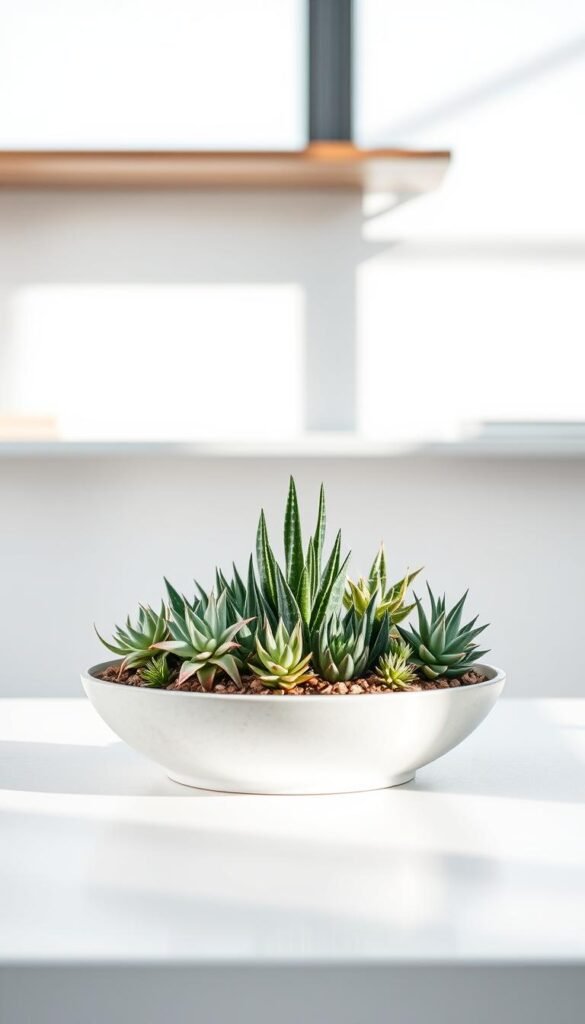Small-scale greenery offers big rewards for urban living. By combining carefully chosen plants in artistic layouts, you can craft living art pieces that thrive on tabletops or shelves. These compact displays let you explore different ecosystems—from rocky desert scenes to lush tropical setups—all within your home.
Today’s design trends favor simplicity and intentionality. Clean geometric containers paired with strategic foliage placement create striking visual balance. You’ll find that limiting varieties to two or three species often delivers the most polished look, especially when contrasting leaf shapes add depth.
Beyond aesthetics, these arrangements provide a calming connection to nature. Studies show caring for indoor greenery reduces stress while improving air quality. Their manageable size makes upkeep effortless, perfect for busy lifestyles.
Whether you prefer bold succulents or delicate ferns, your creation becomes a personalized escape. Try mixing smooth stones with trailing vines for movement, or use elevated platforms to mimic natural terrain. Every detail reflects your unique vision while complementing modern decor.
Introduction to Modern Dish Gardens
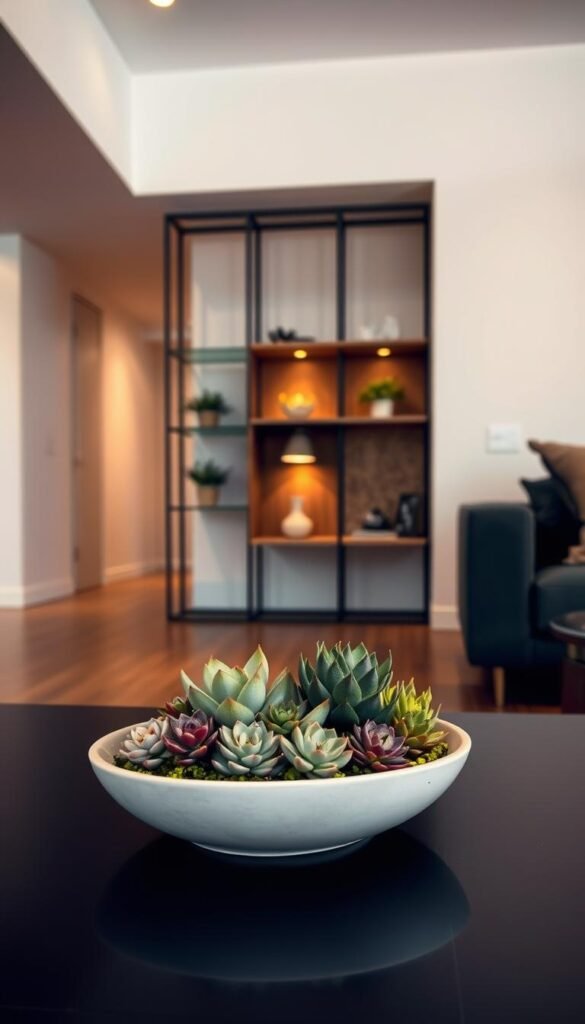
Transform tight corners into vibrant oases with curated container gardens. These miniature landscapes blend plants in creative combinations, offering fresh energy to rooms without overwhelming them. Their compact size makes them ideal for apartments, offices, or anywhere you crave a touch of nature.
Why Compact Plant Displays Captivate
Their magic lies in versatility. You can mix succulents with moss or pair air plants with decorative stones—each combination tells a story. “It’s like painting with living materials,” says urban gardener Lila Chen. This hands-on approach lets you experiment freely, changing layouts as seasons shift or moods evolve.
Low-maintenance varieties thrive in these setups. Many species need water only weekly, perfect for busy schedules. You’ll enjoy watching your tiny ecosystem grow while keeping care routines simple.
Elevating Rooms Through Strategic Greenery
In today’s homes, every detail matters. A well-placed dish garden adds texture and softness to sleek surfaces like marble countertops or metal shelves. Try using angular pots to contrast rounded leaves, or position trailing vines near windows to catch sunlight.
These arrangements do more than decorate—they purify air and boost mindfulness. Studies show caring for greenery reduces stress by 14%, making them functional art pieces. Whether you choose bold colors or muted tones, your creation becomes a focal point that sparks joy daily.
Key Elements of Contemporary Dish Garden Design
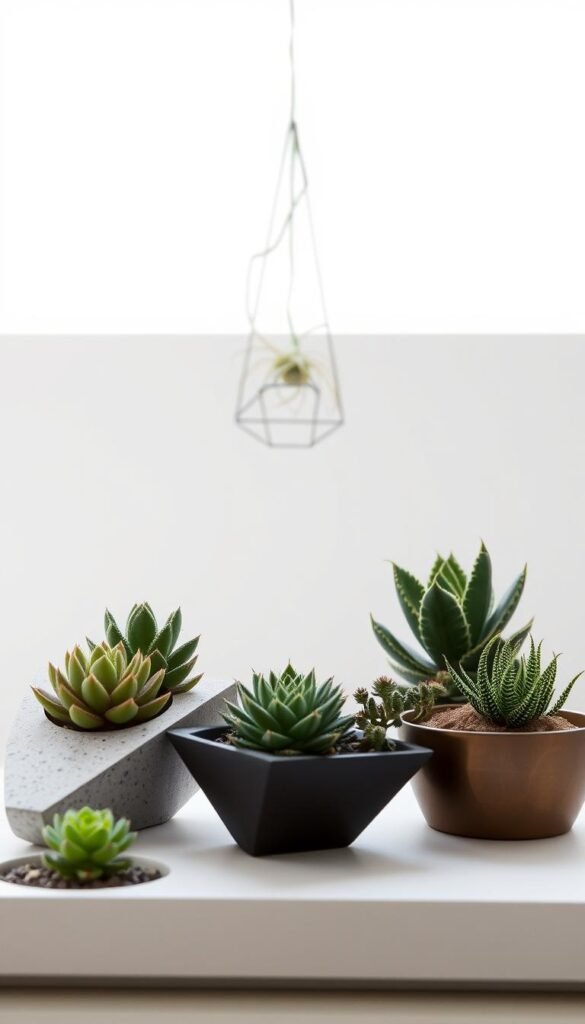
Achieving harmony in small-scale plant displays starts with intentional design choices. Focus on balance between structure and organic growth to create arrangements that feel both deliberate and alive.
Clean Lines Create Calm
Straight edges and uncluttered layouts bring order to your greenery. Think of each leaf or stem as part of a larger composition—every angle matters. Neutral-toned containers with geometric shapes let your plants shine without competing for attention.
Functional layouts prioritize easy care. Group plants with similar light and water needs, leaving space for growth. This approach turns maintenance into a quick weekly ritual rather than a chore.
Material Mixology Matters
Pair raw textures like concrete or weathered wood with glossy metals for contrast. These combinations add depth while keeping the look grounded. As landscape artist Marco Torres notes, “The right vessel elevates plants from decoration to art.”
Choose containers that complement your home’s style. Sleek ceramic bowls suit minimalist spaces, while rustic stone planters enhance earthy interiors. For more inspiration on blending hues, explore our guide to colorful container gardening.
Modern Dish Garden Ideas: Sleek Arrangements for Contemporary Spaces
Reimagine overlooked nooks with living art that thrives in confined settings. Small surfaces become dynamic showcases when you pair spiky cacti with cascading herbs or cluster geometric pots filled with jewel-toned succulents. These compact garden concepts prove size doesn’t limit creativity—it sharpens it.
Start by selecting plants that mirror your environment’s light levels. Sunny windowsills love drought-tolerant sedums, while snake plants transform dim corners. Designer Elena Rivera suggests, “Layer heights using stacked stones or miniature platforms to add drama without clutter.” This approach turns basic groupings into sculptural statements.
Textural contrasts make designs pop. Combine feathery ferns with glossy pebbles or pair fuzzy kalanchoes against smooth concrete planters. For kitchens, try edible arrangements—mint and thyme thrive alongside decorative moss. Offices benefit from air-purifying pothos in shallow trays that fit under monitors.
Adapt these ideas to reflect your style while keeping care simple. Use neutral containers to unify mixed species, or add a bold-colored accent pot as a focal point. Every choice should enhance your room’s flow, whether you’re softening angular furniture or adding life to blank walls.
Discover more ways to energize small spaces through our guide to colorful container gardening. Your personalized green vignette awaits—no backyard required.
Creative Succulent Showpieces
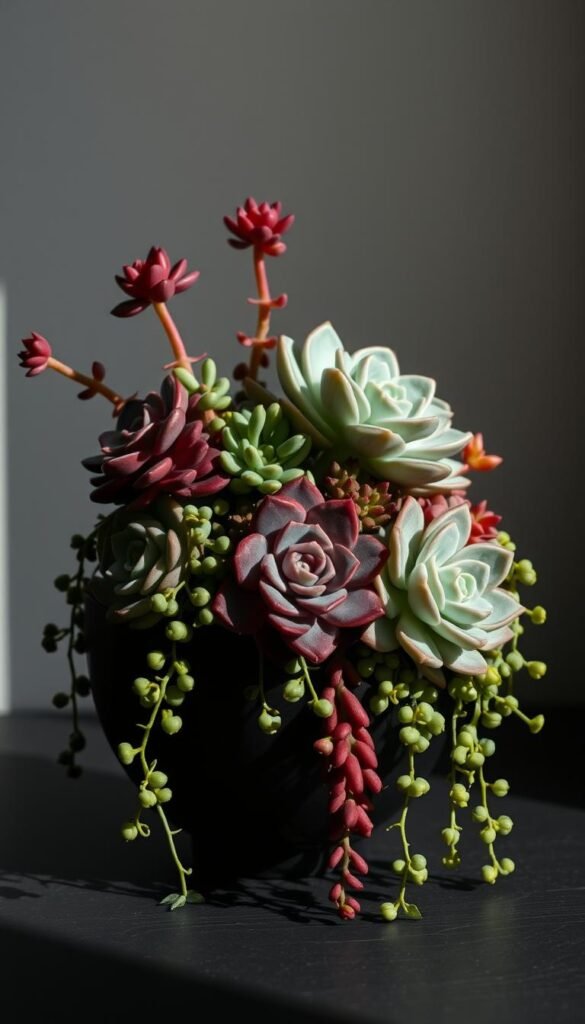
Succulents transform ordinary spaces into living sculptures through their striking forms. These resilient plants thrive in shallow containers, letting you craft eye-catching displays that demand minimal attention. Start by choosing varieties with complementary growth habits and visual appeal.
Plant Selection: Echeveria, Haworthia, and Sedum
Echeveria’s rosette shapes work as natural focal points. Pair them with Haworthia’s striped leaves for contrast. Sedum varieties like ‘Burro’s Tail’ bring cascading energy to your arrangement. “These three create perfect harmony—structure, pattern, and motion,” notes Phoenix-based designer Cara Wu.
Drought tolerance makes these plants like ideal for busy lifestyles. They store water in their leaves, needing hydration only every 10-14 days. Use gritty soil mixes to prevent root rot and ensure proper drainage.
Design Tips for Layering Colors and Textures
Build visual depth by placing taller Sedum varieties behind compact Echeveria. Mix silvery-blue leaves with burgundy-tipped varieties for striking color contrasts. Add rough lava rocks or smooth river stones to enhance texture differences.
Keep arrangements balanced by limiting your palette to three main colors. Warm terracotta pots make green tones pop, while white containers highlight subtle hue variations. Rotate your display weekly to ensure even light exposure and symmetrical growth.
Herb-Infused Mini Garden Concepts
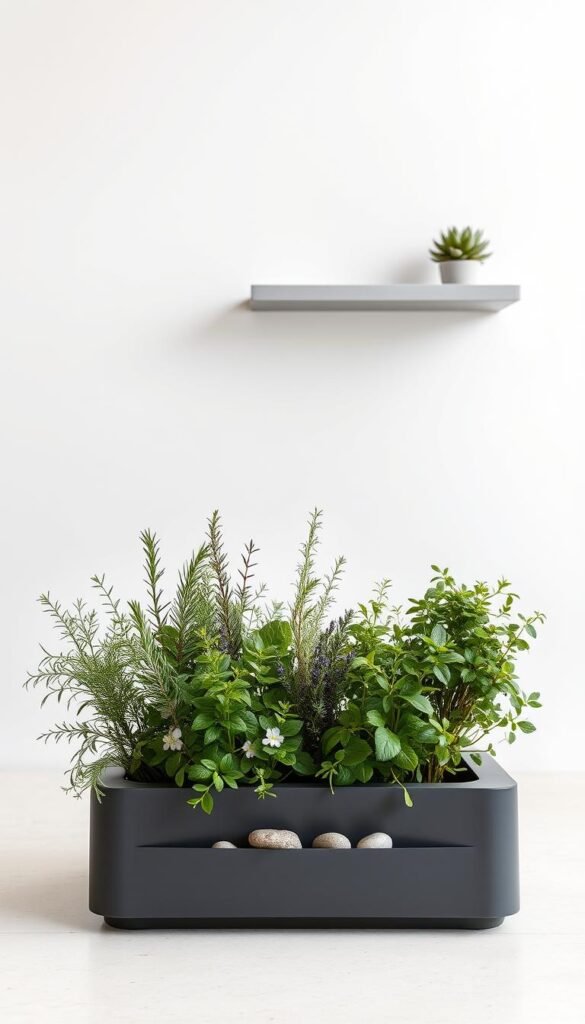
Elevate your kitchen countertops with living flavor stations that look as good as they taste. These edible gardens let you snip fresh seasonings while adding vibrant energy to your space. Choose shallow containers with drainage holes to keep roots healthy and prevent waterlogging.
Best Herbs to Grow in Compact Dish Gardens
Three varieties shine in small setups: basil, mint, and thyme. Basil thrives in sunny spots, its glossy leaves releasing fragrance when brushed. Mint spreads quickly—plant it in separate compartments to control growth. Thyme’s delicate stems cascade beautifully over container edges.
| Herb | Light Needs | Growth Habit | Culinary Uses |
|---|---|---|---|
| Basil | 6+ hours sun | Upright | Pesto, salads |
| Mint | Partial shade | Spreading | Cocktails, teas |
| Thyme | 4-6 hours sun | Trailing | Soups, roasts |
Chef Naomi Park recommends, “Group Mediterranean herbs like oregano and rosemary together—they share water needs and complement each other’s flavors.” Use gritty soil mixes for these drought-tolerant plants, watering only when the top inch feels dry.
Rotate containers weekly for even growth. Trim leaves regularly to encourage bushier shapes. Pair with decorative elements like mini terracotta pots or copper labels for visual interest. Your edible garden becomes both pantry and decor, proving gardening thrives even in tight spaces.
Tropical Plant Arrangements for a Lush Look
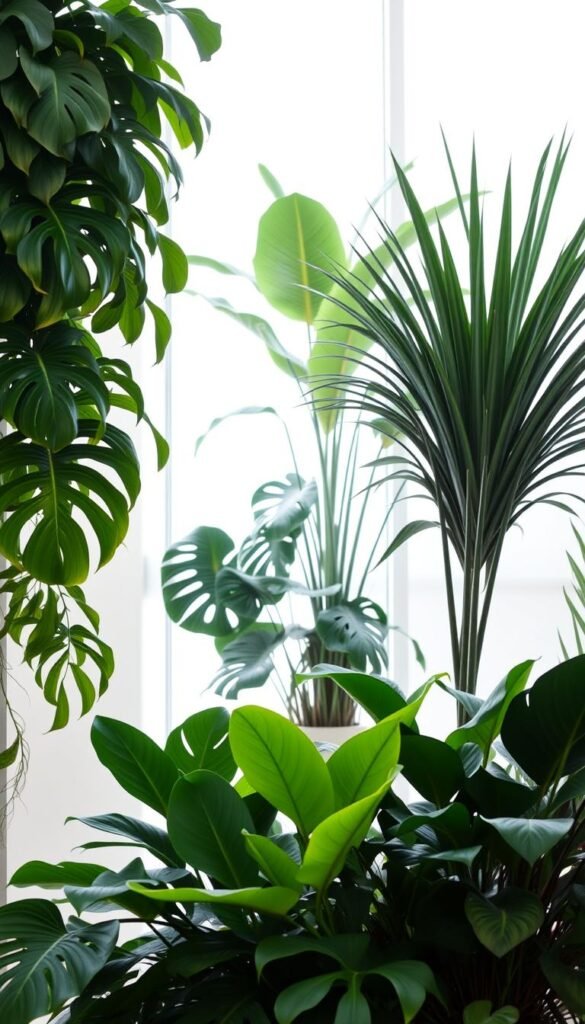
Bring the tropics indoors with vibrant plants that turn any room into a leafy paradise. These lush displays combine bold textures and rich colors, creating depth that feels both wild and intentional. Start by selecting species that thrive together while complementing your home’s light conditions.
Choosing Vibrant Ferns and Orchids
Bird’s nest ferns add drama with their wavy leaves, while delicate orchids bring elegance. Pair them with bromeliads for pops of color—their pineapple-like shapes create striking focal points. “Mixing heights and leaf sizes mimics natural rainforest layers,” notes Miami botanist Dr. Rosa Mendez.
Use shallow containers with drainage holes to prevent root rot. Line the bottom with pebbles before adding chunky orchid bark mix. This setup lets roots breathe while maintaining moisture—key for tropical varieties.
Watering and Humidity Considerations
These plants crave consistent moisture but hate soggy soil. Water when the top inch feels dry, using room-temperature water to avoid shock. Mist leaves every other day or place pots on pebble trays filled with water to boost humidity.
Bright, indirect light keeps colors vibrant without scorching leaves. Rotate your garden weekly for even growth. With proper care, your arrangement becomes a living centerpiece that elevates your space like these gardening aesthetic tips suggest.
Dish Gardens for Low-Light Environments
Not every corner gets abundant sunshine, but that doesn’t mean they can’t flourish with greenery. Low-light dish gardens turn dim areas into thriving displays using resilient plants that adapt to indirect light. These arrangements prove shadows can host vibrant life when you choose the right species.
Opting for Hardy, Shade-Tolerant Plants
Snake plants stand tall with sword-like leaves, purifying air while needing water only every 2-3 weeks. Pothos vines cascade gracefully from shelves, their heart-shaped leaves brightening north-facing rooms. ZZ plants like these thrive in offices or bathrooms where natural light stays limited.
Combine textures for visual interest: pair snake plant rigidity with pothos softness. “These species are survival artists,” notes interior designer Jamal Reyes. “They transform neglected spaces into living focal points without demanding constant care.”
Use shallow containers with drainage to prevent root rot. Layer charcoal beneath soil to keep roots healthy. Rotate your dish gardens monthly to ensure even growth patterns, maintaining their sculptural appeal in any low-light setting.
Seasonal Flower Displays in Dish Gardens
Refresh your space every few months with living calendars of blooms. By rotating seasonal flowers, you mirror nature’s rhythm on tabletops or windowsills. This approach keeps your gardens vibrant while celebrating each season’s unique charm.
Spring bursts to life with tulips’ cup-shaped blooms and daffodils’ sunny trumpets. Pair them with pansies for a confetti-like effect. Summer shines through zinnias’ bold hues and lavender’s fragrant spikes—perfect for sunny spots.
| Season | Flowers | Key Feature |
|---|---|---|
| Autumn | Mums, Marigolds | Rich warm tones |
| Winter | Amaryllis, Holly | Festive textures |
Arrange by height—place tall stems like sunflowers at the back, trailing ivy at the front. “Contrast velvety petals with spiky evergreens for winter drama,” suggests florist Nina Patel. This creates depth while letting each plant shine.
Transition smoothly between seasons by prepping containers. Remove spent blooms, refresh soil, and introduce new starters gradually. Your display evolves effortlessly throughout the year, always reflecting nature’s current palette.
Mix textures and color intensities for maximum impact. Soft pastels work in spring, while autumn craves burnt oranges and deep reds. With smart planning, your seasonal flowers become a rotating art exhibit that never loses its freshness.
Minimalist Rustic Dish Garden Designs
Embrace the quiet elegance of nature with dish gardens that blend raw textures and purposeful simplicity. These designs celebrate the beauty of weathered surfaces and organic shapes, creating spaces that feel both curated and effortlessly natural. Start by choosing materials like rough-cut wood slabs or hand-thrown clay pots—their imperfections add character without overwhelming your space.
Focus on drought-resistant plants that thrive in shallow containers. Air plants and compact succulents work beautifully, needing minimal water while complementing earthy materials. “Let each element breathe,” advises designer Clara Holt. “A single trailing sedum in a stone trough can make a stronger statement than crowded arrangements.”
Stick to neutral tones for cohesion:
- Warm terracotta pots
- Driftwood accents
- Slate gray pebbles
These choices highlight greenery while maintaining visual calm. Avoid clutter by limiting your palette to three main elements—container, plant, and one textural accent.
Your finished piece becomes a meditation in balance. Natural materials like unglazed ceramics age gracefully, developing patinas that deepen their connection to the environment. This approach proves simplicity isn’t stark—it’s an invitation to appreciate subtle details often overlooked.
Hanging and Vertical Dish Garden Concepts
Redefine your walls and ceilings as canvases for living art. Vertical gardens multiply your growing potential without stealing floor space, ideal for compact urban homes. These three-dimensional designs turn blank surfaces into cascading greenery that breathes life into overlooked areas.
Utilizing Vertical Space with Creative Planter Options
Macramé hangers and repurposed tin cans add personality while saving square footage. Trailing plants like string-of-pearls or pothos create flowing curtains of foliage. “Vertical gardening isn’t just practical—it’s poetry in motion,” notes Boston designer Leah Nguyen.
Choose drought-resistant varieties for easy upkeep. Succulents thrive in hanging baskets with minimal watering. Wall-mounted systems let you mix textures—pair spiky air plants with soft moss for tactile contrast.
Smart placement enhances functionality:
- Install floating shelves near sunny windows
- Use tiered planters to maximize balcony corners
- Hang lightweight containers over kitchen islands
Proper drainage prevents water damage—line baskets with coconut coir or use pots with built-in trays. Rotate plants monthly to ensure even growth. Your vertical oasis becomes a conversation starter that works harder than traditional setups.
Miniature Terrariums and Compact Arrangements
Discover the joy of crafting enclosed gardens that require minimal care. These self-contained ecosystems let you design lush landscapes in glass vessels, combining practicality with artistic flair. Start with a clear container—mason jars, fishbowls, or geometric terrariums work beautifully—to showcase layered textures and thriving plants.
DIY Tips for Self-Contained Setups
Begin by lining your container with pebbles for drainage, then add activated charcoal to keep the environment fresh. Use a lightweight soil mix suited to your plants—succulents prefer sandy blends, while ferns thrive in moisture-retentive potting medium. Small-scale species like baby tears or air plants adapt well to confined spaces.
Repurpose household items creatively: vintage teacups become whimsical planters, and old colanders offer built-in airflow. For guidance on container selection, explore our step-by-step container gardening guide. Arrange plants by height, placing taller varieties at the back and trailing ones near the edges.
Mist occasionally, but avoid overwatering—closed terrariums recycle moisture naturally. Open designs need weekly hydration. “The magic lies in balance,” notes terrarium artist Diego Cruz. Low-maintenance choices like moss or snake plants ensure your miniature world stays vibrant with little effort.

